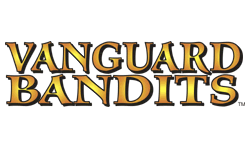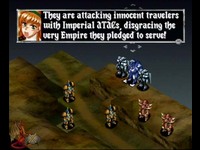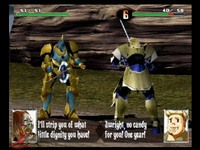|
|

|
PLATFORM
|
PS1
|
BATTLE SYSTEM
|

|
INTERACTION
|

|
ORIGINALITY
|

|
STORY
|

|
MUSIC & SOUND
|

|
VISUALS
|

|
CHALLENGE
|
Moderate
|
COMPLETION TIME
|
Less than 20 Hours
|
|
OVERALL

|
+ Investing tactical action
+ Considerable replay options
+ Entertaining Working Designs translation
- Clunky menus
- Limited interview options
- AI-controlled allies
|
Click here for scoring definitions
|
|
|
Working Designs had a pretty good track record when it came to picking worthy Japanese games for exposure across the Pacific, and Vanguard Bandits is not a black sheep in the company's output. Human Entertainment's tactical title does some interesting things that make it worth experiencing years later, and Working Designs' decision to change its name from Epica Stella was probably the right one. Though time has not been kind to certain aspects, Vanguard Bandits still justifies the effort that was expended bringing it to North American audiences.
Bastion is a young man with a deep-seated hatred of the Junaris Empire, something that he gets to take action on when Imperial soldiers start showing up in his vicinity. While initially nothing more than an angry young man's one-note bellicosity, Bastion's attitude gets further shaped when his adoptive father Kamorge is killed to protect him from the dangerous attention of chief Imperial evildoer, Faulkner. Kamorge lets slip before death that Bastion is the long-lost prince of a kingdom conquered by the Empire years before, which sets in motion a quest to liberate the continent. Bastion gathers allies for this task, but has to accommodate himself to the reality that not everyone in the Junaris Empire is a power-hungry slaughterer of peasant hordes, notably the princess Sadira.
Vanguard Bandits' default storyline is effectively told courtesy of the Working Designs scriptwriters but nothing very original. Completing the whole thing can be done in less than twenty hours however, and doing so is the prerequisite to open branches for different paths to the conclusion. A total of five potential endings exist, though the paths to reach each one go through some common ground. The variety of scenarios displayed make the story quite interesting on some roads.
As a Working Designs release, the text is highly readable and entertaining. The company's usual penchant for references that date quickly is restrained for this title, though a couple did still slip through for Triumph the Insult Comic Dog and Olestra. This is forgivable in light of the slipshod style that so many publishers still used as of 2000 for RPGs.
Bastion and his compatriots occupy giant robots termed ATACs when doing battle, and their struggles at first look like many other tactical titles. Characters take their actions and move around the square grid of a battlefield to act against the enemy, with movement and actions coming from an action point gauge that can prohibit using powerful skills after a long walk. The choice of defending, avoiding, or counterattacking the enemy is available at times to keep some variety. Though it requires opening the menu, a turn order meter is available for viewing at any time, a handy feature not universally seen at the time.
 Sadira strikes a tone of moral outrage, and isn't afraid to follow up with violence to ensure her point is made.
Sadira strikes a tone of moral outrage, and isn't afraid to follow up with violence to ensure her point is made.
|
|
What makes Vanguard Bandits stand out is its Fatigue Points system, in which each action taken drains the user's stamina. Even avoiding repeated enemy attacks is fatiguing, and once a character's stamina reaches the maximum he or she will sit immobile as an ideal target on which the enemy will gladly practice. This holds true for the opposition, and is often the key to surviving strong adversaries. This ensures that winning in battle is a team effort, since any single character will get fatigued by trying to do too much. Combat also stays interesting because the scenarios are varied enough to never feel boring, a key ingredient to any lasting tactical title.
Something more commonly seen is the presence of AI-controlled characters on the player's side for a number of encounters. While they rarely need to be kept alive, their unvarying preference to charge straight into the enemies means they are likely to upset plans and get killed. It is fortunate that allies eventually cede control to the player after demonstrating their mental inadequacy a few times in early battles, because their remarkable propensity for stealing the spoils of victory by killing enemies is always in evidence when they are not being pounded into the dirt.
Between battles the player will have ample time to become familiar with the intermission menu, which gets the job done but could have used considerable refinement. Shopping is only a periodic option in the game, and when it does become available the player will need a good memory to see which characters are capable of using certain equipment since the effect of new equipment is obliquely displayed. Certain items provide access to new skills, but the only way to know what they do in a fight is to equip them and see, since the name of a technique is the only thing told to the player when equipping items. Limiting the interview option to only three characters per intermission is also unnecessarily constraining when doing this raises the morale of the team while tossing out plenty of amusing Working Designs dialogue, since how good characters feel about Bastion has an effect upon the path taken by game's end.
Most of Vanguard Bandits is depicted via sprites, which are not deformed when depicting humans and thus stand out. The robots and battlefield animations do not benefit from close observation but succeed in displaying necessary information without being egregiously ugly. As in many tactical games, the view shifts to a more detailed animation when actions are taken against the enemy, and by the standards of the PS1 this display of polygons is adequate. Helping matters considerably is the brevity of load times for these animations, but they can still be disabled at any time should irritation outweigh the interesting banter between the combatants shown during these scenes.
 My - my candy! What happened to it? I'm sorry, hitting you wasn't worth this penalty!
My - my candy! What happened to it? I'm sorry, hitting you wasn't worth this penalty!
|
|
While not widely varied, the score of Vanguard Bandits is enticing enough to warrant being heard most of the time. It complements the action effectively and introduces new compositions regularly enough to not become dull. Voice acting is absent except, unexpectedly, during the final battle scene, where its sudden appearance is startling and hard to judge.
Vanguard Bandits rewards playing cautiously, and attempting to charge at the enemy will not go well. Players exercising some patience will not find the difficulty very high, though it varies depending upon the path being taken. Aside from the victims feeling poorly about Bastion's leadership there is no penalty for letting teammates be beaten in a fight, which can be helpful in tight spots.
While it hasn't aged superbly in all respects, Working Designs chose wisely in bringing a game that otherwise would have been even less remembered across the Pacific. It features interesting tactical scenarios that will remain investing for years to come, while its cumbersome menus are not so arduous as to render the product undesirable. The PS1 era and me have a sometimes-rocky relationship, but I can still see why people would enjoy this game.
Review Archives
|









